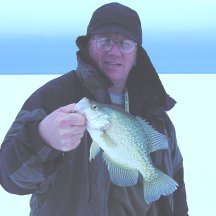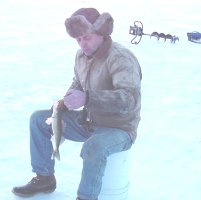|
Northern Minnesotaís Early Ice Bonanza
December 2003
Jeff Sundin
In an area rich in fishing traditions like Northern
Minnesota, first ice and the opening of the ice fishing season is as
important to some as the spring fishing opener is. It's a time of the year
that is a mystery to most of the folks whoís fishing time ends with the
summer. While lots of folks are watching football and practicing their
favorite couch potato positions, icehouses gather on shorelines as
paper-thin ice slowly forms, gaining strength to support the traffic that is
soon to come. For die-hard ice anglers, this is the eve of the "real fishing
opener" and for the next few months, they'll spend most of their free time
on the ice. Do they know something we don't? You bet they do!

Early ice provides all of the makings for a dream trip.
Hungry fish gathered in large groups, decent weather and best of all, easy
drilling! First ice is really an extension of late fall. Fish locations
remain fairly stable as they continue their fall feeding binge in
preparation for the long winter to come. Fish that have gathered in
preferred feeding areas will remain in these locations until fishing
pressure and weather conditions force them to move on in search of better
opportunities.
Before I say another word, letís start with safety.
Thereís not enough fish in the world to make it worth you or your fishing
partner risking your life on "bad ice". Anxious anglers are sometimes known
to push the limit and even experienced ice anglers can get into trouble when
theyíre not thinking. Safety is always the first concern.
Early ice fishing is a team sport, always go with
partners and make sure you have agreed to stay near by, but spread out far
enough to distribute weight over a safe area. Never leave shore without a
safety rope, throwable boat cushion, a spud for checking ice thickness, and
handspikes like the Life Guardš Spikes offered by
Strikemaster. Wear the spikes by attaching each one to the same rope and
stringing them through the inside sleeves of your coat, behind your
shoulders so they hang at the ready from each wristband. If you need them,
theyíll be there. Use the spud as a probe punching the ice ahead of you and
if it ever breaks through easily, find a different route to your fishing
area or turn back. Always follow rule number 1! If youíre not sure thereís
enough ice ahead of you, donít go out there.
One nice thing about early ice is that you can travel
light. A sturdy sled that contains a couple of buckets, a few rods, portable
flasher and maybe a small portable heater is really all you need. For early
ice of six to 15 inches, a hand auger will drill all the holes you need. A
5-inch Lazerš hand auger is fantastic for this
job and cuts the ice like butter. Power augers will come in handy later in
the winter, but for now, theyíll slow you down. Protect your blades, keep
them sharp and youíll have more time to fish and less cargo to worry about.
|
A travel tip that youíll like for carrying minnows is to
put some in a zip lock bag with a little slushy ice water instead of using a
bucket. In the cold weather, minnows will stay alive all day long in the bag
and itís a lot easier to carry around. Just donít let them freeze; keep them
in your coat pocket or in a small cooler in between bait changes.
Early ice is a great time for multi-species trips because
itís tailor made for fishing small, protect lakes and thereís often one
species biting during daylight and another one that perks up toward evening.
There are a variety of combinations possible, but here some tips on a couple
of my favorite combo trips.
The Perch and Walleye trip during early ice is a medium
to small lake pattern and the action can be good for both fish at the same
time. But most often the Perch will bite during daylight hours and the
Walleyes will move much better toward evening. This early ice pattern is
different from most winter Walleye fishing in that it focuses on the shallow
weedline fish rather than the fish located on the deeper humps. These deeper
structures will be good producers within a couple of weeks, but this first
ice shallow bite is reliable and these spots are a lot easier to get to,
especially on foot. One of my all time favorite ice spots for Walleye is a
small gravel point adjacent to a patch of cabbage weeds in five feet of
water within a couple of blocks of the landing. You donít have to go a long
way to find fish because many of these shallow areas still hold bait and
fish remaining from the fall runs.
Shallow breaklines near large weed flats, clam beds or
gravel bars and points along the weedline are like gold and many of them
will produce fish year after year. Perch will usually be located up on top
of the shallow flats during the day and an active approach, drilling lots of
holes will be best. Occasionally take a look at the drop off areas and
deeper points adjacent to these shallow flats. Active fish bite within a few
minutes, so we donít spend much time in un-productive spots. Jigging baits
with treble hooks like the Swedish Pimple or Jigging Rapala should be tipped
with a minnow head. Swimming Jigs or plain jig heads with single hooks are
best tipped with whole minnows. We jig actively, sharply lifting the jig and
letting it fall back just above the bottom. Lifting your jig from the bottom
and holding it there will often trigger the fish to follow it up. Watch your
flasher screen like a hawk and be ready to tease these following fish by
lightly jiggling your rod tip.
Walleyes are often present near the same locations as the
Perch. They might be a little deeper or holding more tightly to the drop
off. These fish can be seen on the flasher, but not often caught during the
day. By late afternoon as the sun goes down, they will bite for an hour or
so and the action can be fast and furious. Your best bet is to keep track of
areas where youíve spotted fish during the day a take your best educated
guess of where to set up for the evening. Itís important to remember you
wonít have a lot of time to fool around. I like to have holes pre drilled
that range a few feet in depth and cover the structure in a variety of ways.
For example, Iíll have some holes near weeds, some on the drop off and maybe
a couple on a shallow point. I always drill the holes in pairs so I can fish
two rods within easy reach of each other because it can be important to vary
your approach on these late afternoon Walleyes. |
One great approach is to rig one rod with a slip bobber,
split shot sinker and a plain hook tipped with a larger lively minnow like a
Rainbow Chub, Golden Shiner or Red Tail. Fish this rig in one hole while you
jig more actively in another hole. Weíve seen lots of fish come in to take a
look at the jigging spoons and then slowly swim away. Some of these
"lookers" spot the bobber rig and stick around for the easy meal on the
other rod. You could do the same thing using tip ups, but it takes longer to
get them set and Iíd rather use the extra time to fish. You can leave the
bobber rig set as you check some of the other holes with your jigging rod.
Once you find the best area, re-locate the bobber rig and repeat the process
if needed.
The Pike and pan fish combo is my favorite early ice trip
because itís perfect for small lakes and it provides lots of action with
frequent moves. Youíre busy all day long, so staying warm is easy plus you
get a good look at the layout of a lake. Start by finding the weed edges
along the shoreline. Itís best to find the outer edges where moving Pike can
easily see your bait along the breakline. Water depth will be 6 to 12 feet
on most lakes, maybe a bit deeper on some. Set your first couple of holes
with tip ups rigged with a 3/8-ounce egg sinker, barrel swivel and a 2/0
hook tied to a 24 inch, 17 to 25 pound test monofilament leader. Once you
have a couple of tip ups set, move down the breakline about 25 yards or so
and drill your next hole, remove the tip up from your first hole and re-set
it at the new location. Continue this leap frogging or trolling down the
shoreline as you search for the most active locations.

Early Ice is a
great time to gather some "eaters" for one of those early winter fish fries.
They sure taste good after a few months without a meal of fish.
As you watch your tips ups, make short trips into deeper
water and check for schools of Crappies or Bluegills on your flasher.
Thereís no need to drill holes for this, just put a little water on the
surface of the ice and set your transducer in the small puddle. You will get
a good reading through the ice. When you spot schools of fish in the deeper
water, make note of these spots and prepare holes in these locations. As
late afternoon approaches, remove your tip ups and head to your pan fish
locations to prepare for the traditional evening run. Simple slip bobber
rigs using small ice jigs tipped with minnows or wax worms will be a good
starting point. I use my flasher religiously to locate fish and help
determine how active they are. When you spot fish on the screen, raise your
jig just above them and watch how they react. Active fish will come up and
bite immediately. Less active fish may take a look and swim back down. Move
from hole to hole and check back on the ones where youíve seen the most
fish. As a rule, there will be a spurt of action just before dark and it
pays to be in the prime locations when it starts.
First ice is a great time to enjoy most everything ice
fishing has to offer. Travel safely and enjoy a few of these early winter
outings. Youíll come back for more. |
